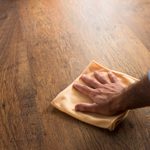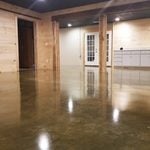Homeowner’s Guide To Hickory Hardwood Flooring

Hickory hardwood flooring combines ultra-durability with a unique grain pattern, making it an attractive alternative to more common flooring options.
A strong, hard, dense wood, hickory is a popular choice for applications that require maximum durability, like tool handles, sporting equipment and, of course, flooring.
Ralph Severson, owner of Flooring Masters, says hickory’s density makes it stand up so well against wear, tear and general abuse. “Oak is always the first choice for flooring, but hickory is a more unique option,” he says. “Many believe that oak is more aesthetically pleasing, but hickory is gorgeous as well.”
On This Page
Hickory Hardwood Flooring Pros
- Durable;
- Resistant to mold, termites and warping;
- Unique, irregular pattern and grain.
Hickory Hardwood Flooring Cons
- Dense fibers can be difficult to cut and install;
- More expensive than oak;
- The busy grain pattern is not ideal for narrow boards.
Hickory Hardwood Flooring Design Considerations
Grade
The grades of hickory — first, second and third — denote the level of defects, imperfections and color variances. Those who want a clean, blemish-free look should consider first-grade hickory. For something more rustic and irregular, go with a third-grade option.
Cost decreases as you go from first to third. Grade three, in particular, would look exceptional in a cabin or other rustic structure. Keep in mind that these grade titles can vary from one supplier to another, although the descriptions will be the same.
Dimensions
The unique “busy” grain pattern of hickory wood — think lots of swirls, swoops and knots — makes it better suited for wider planks, so it may be difficult to find hickory in narrow widths. If you want the traditional look of narrow plank flooring, you might not find it in hickory.
Color
The color palette can range from light beige to brown to red. These contrasting colors make it a unique, eye-catching choice for those who want to differentiate their floors from traditional pine or oak.
However, all that variation is off-putting to others who prefer a traditional look. Keep in mind scuffs and marks will be more visible on lighter colored boards, so those might not be great for high traffic areas. Just like other wood flooring options, unfinished hickory boards can be stained to alter the color.
Hickory Hardwood Flooring Installation
The hardness that makes hickory so durable and strong also makes it more of a challenge to install. Severson notes that cutting hickory during installation is difficult, so for most homeowners it’s best to hire an experienced professional hardwood floor.
If you do decide to tackle it yourself, make sure your chop saw has a good-quality carbide blade. And be aware that the hardness of the wood makes it more likely to split and break when nailing.
Hickory Hardwood Flooring Costs
Although hickory is abundant in North America, it’s not most commonly chosen for hardwood flooring, so supply is lower than for oak or maple. This relative scarcity makes hickory more expensive.
Combined with the challenging installation, it could result in a high price tag overall. If you’re on a tight budget and are set on choosing hickory, you may have to settle for a lower grade.



